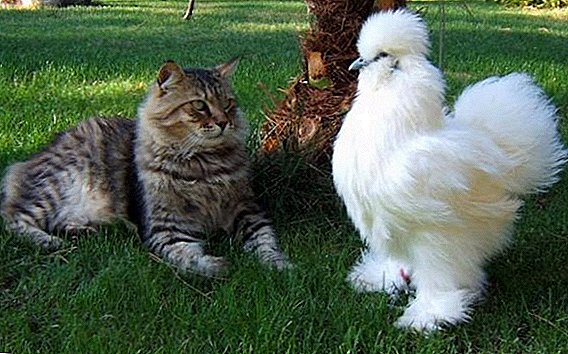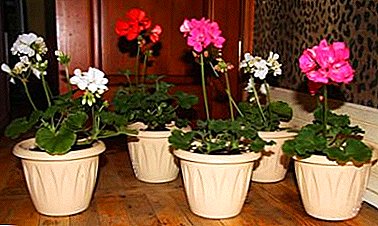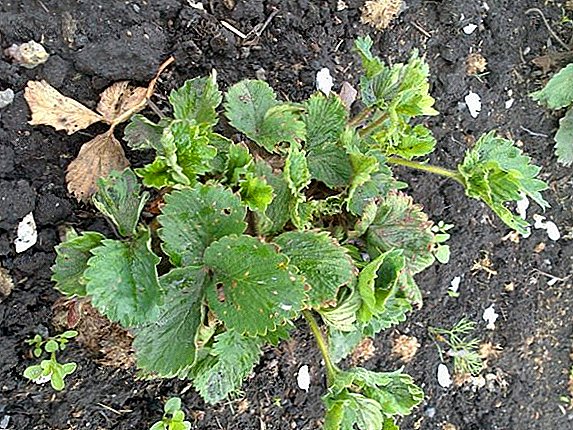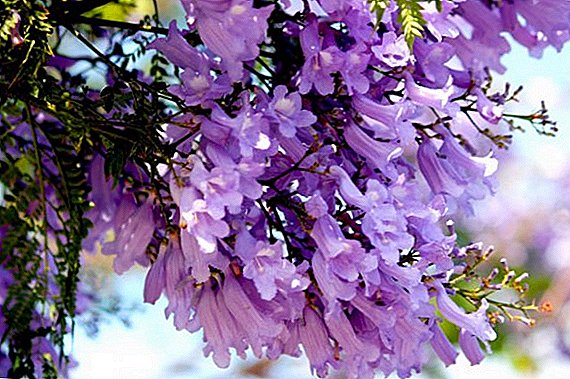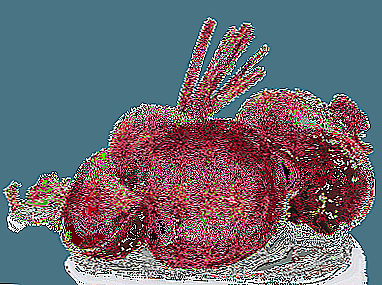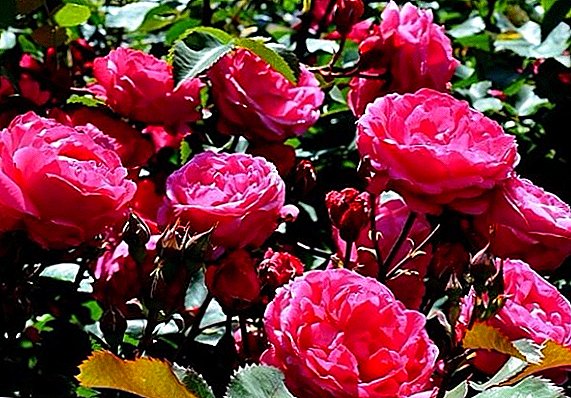 North Canada has a rather harsh climate, and it is not easy to grow roses there. In the twentieth century, a state-funded project was created to remove frost-resistant pink shrubs. Scientists and breeders have achieved success in their work, the results of their work decorated not only the gardens and parks of Canada, but also the sites of roses lovers from different countries.
North Canada has a rather harsh climate, and it is not easy to grow roses there. In the twentieth century, a state-funded project was created to remove frost-resistant pink shrubs. Scientists and breeders have achieved success in their work, the results of their work decorated not only the gardens and parks of Canada, but also the sites of roses lovers from different countries.
The main advantages of the Canadian rose
The varieties of Canadian roses are so resistant to cold that they can grow even in Alaska. The plant does not die at -45 ° C, it is not afraid of sudden changes in temperature, the stems quickly recover if frozen. These roses are distinguished by lush and long flowering, all summer and autumn, up to the first cold weather, they will decorate your site. Canadian rose resistant to diseases and pests, easily tolerates shade and does not suffer from a lack of lighting. The plant is unpretentious to the conditions, it is more pleasure to care for it than a duty. Shrubs have a beautiful shape, thick, lush foliage of bright shades, large flowers of various colors. 
Did you know? The beauty and aroma of roses has always inspired poets, prose writers and musicians to create songs, odes, fairy tales and other works. This is Solomonov's "Song of Songs", and Rustaveli describing the gardens of Semiramis. Shakespeare mentioned in his poems about roses more than fifty times, in the huge library of wise Confucius there were about six hundred volumes of roses or with mention of a flower, only in the American states they composed about four hundred songs about roses.
Popular varieties of Canadian roses
The assortment of Canadian selection roses is represented by two groups: park and climbing roses. Let's talk about those and other more. The first group is resistant to drought, easy to maintain. These varieties look good in a single planting, and in various compositions, they easily take root in any areas. Park roses bloom in May in lush flowers, in which there are about a hundred petals. Petals of a various color: from snow-white to an ink shade. Their difference is that, having flowered in July, after some rest, the rose blooms again and blooms before the first frost. After flowering, roses are decorated with bright fruits, which also adds decoration to them.
Park Canadian roses are presented in the following varieties:
- John Davis - a variety with soft pink flowers and a pronounced aroma. In the inflorescence in the form of a brush from 10 to 15 flowers are collected. Shrub reaches 2.5 m in height, crown diameter up to 2 m.
- John Franklin - a low bush up to 1.5 m, crown about 1 m in diameter. The flowers of this variety resemble a carnation: red and terry, with a fringe on Kant. Bush blooms and single flowers and buds.
- Morden Sunrise is a compact bush in a meter high and with the same width. Blooms large bright orange flowers.



- Martin Frobisher - the first grade of this group. It grows shrubs up to 8 m tall. The branches have almost no thorns, the flowers are collected in brush-like inflorescences of a pale pink shade.

Did you know?Martin Frobisher is an unlucky British navigator. In the XVI century, he dreamed of opening the Eastern Lands, but he found himself in North America. There is a certain irony in the fact that the first frost-resistant variety of roses is named after him.
- Quadra - shrub with flexible shoots, well developed on supports, shoots grow to 1.5 m in length. Blooms the entire warm period of the year with bright red flowers.

Proper planting roses
Canadian rose is easy to plant in the garden: it easily gets along with other flowering plants. It all depends on your imagination in the composition.
Selection of seedlings for planting
For planting choose strong seedlings with long legs. Leaves are removed from the shoots, except for a pair of upper ones. Saplings should have small roots: do not damage them when planting.
Optimum timing and site selection
The best period for planting is autumn. During the winter, the root system will get stronger and develop, delighting in spring with strong branches. Canadian roses love the sun, but do not plant them under direct sunlight. The best option when choosing a place would be a well-ventilated, slightly shaded area.
Important!Undesirable landing on the south side of the house. Under the influence of the sun in winter, the snow often thaws there and freezes again. Such drops promote freezing of shoots.
Soil preparation for planting seedlings
 Before planting, prepare a place and ground. Hole dug size 70x70 cm It is necessary to fill the hole with loose non-acidic soil, fertilized with a complex of organic and mineral compounds. As organic matter you can use humus, peat, fine wood ash. After planting, seedlings are desirable to pile up.
Before planting, prepare a place and ground. Hole dug size 70x70 cm It is necessary to fill the hole with loose non-acidic soil, fertilized with a complex of organic and mineral compounds. As organic matter you can use humus, peat, fine wood ash. After planting, seedlings are desirable to pile up.
Proper care of Canadian rose
Canadians do not need careful care, the plants are not capricious. The main care for Canadian roses takes place in spring and summer. Minimal watering, shaping pruning and light shelter for the winter - that's all they need.
Did you know?The rose is often referred to as a Christian symbol. In medieval Christianity, it is a symbol of heavenly bliss, consolation in the faith; Saint Cecilia wore a crown of roses. In the Divine Comedy, Dante the rose is a symbol that unites the souls of the righteous; in Blok’s poem The Twelve, a crown of white roses was with Christ; in ancient myths it is an indispensable attribute of Eros and Cupid.
Modes of watering and fertilizing the soil
Watering roses is carried out from spring to summer inclusive. You need to water in the morning or in the evening, 2-3 times a week. During heavy rains watering is not needed. Ensure that the soil is well moistened. Water under the root, trying not to fall on the leaves and shoots. In late summer and autumn, watering is not necessary so that late shoots do not grow. Top dressing of roses is carried out the next year after landing. In the spring, apply liquid mineral fertilizer after watering.
Pruning bushes
 Bushes need pruning every year. Remove old and damaged branches, growing young growth. In this way you will form a crown and send nutrients to flowering branches. After flowering, remove the branches that do not give inflorescences. All places slices necessarily process garden pitch.
Bushes need pruning every year. Remove old and damaged branches, growing young growth. In this way you will form a crown and send nutrients to flowering branches. After flowering, remove the branches that do not give inflorescences. All places slices necessarily process garden pitch.
Shelter bushes for the winter: is it necessary
Despite the fact that the Canadians are the most cold-resistant roses, young bushes should be covered for wintering. To do this, you need to spud the bushes, and wrap the branches with craft paper. Thanks to this, the plants will not get cold and will be protected from the aggressive winter sun.
The main ways of reproduction of Canadian roses at home
The simplest and most popular methods of breeding canadas are dividing the bush, layering and offspring, grafting. Climbing roses better take root cuttings or layering. So they take root and endure winter better. Park roses are best propagated by layering. They form their own root system at the end of the year.
Layering
 With this method, a groove is dug near the adult bush, into which, without separating from the parent bush, the middle part of the branch is laid. The stem is pressed with a clip made of a piece of wire. It is desirable in the part of the stem, which will be in the ground, make an incision for the formation of its own roots. Branch sprinkled with earth, on the surface remains part with leaves and two buds. If the layering is not allowed to take roots, they are left for the winter, covering with peat. Separated from the bush in the spring.
With this method, a groove is dug near the adult bush, into which, without separating from the parent bush, the middle part of the branch is laid. The stem is pressed with a clip made of a piece of wire. It is desirable in the part of the stem, which will be in the ground, make an incision for the formation of its own roots. Branch sprinkled with earth, on the surface remains part with leaves and two buds. If the layering is not allowed to take roots, they are left for the winter, covering with peat. Separated from the bush in the spring.
Important! It is not recommended to do a lot of layering on one bush, the plant in this case is greatly weakened and can be overwhelmed.
Dividing bush
Perhaps the easiest method of breeding roses - the division of the bushes. The division of the bush is best done before the buds bloom. Shrubs gently dig and pruning shears into several parts. Each bush should have branches and roots. If necessary, the shoots pruned, leaving only a few buds. All cuts need to be smeared with garden pitch, then dipped in a mixture of clay and humus and planted in the soil.
Lignified or green cuttings
 Reproduction of lignified cuttings occupation is more tedious than the same method, but green. Harvest similar cuttings at the end of autumn from stems half a centimeter thick. Ready cuttings are stored in the refrigerator, wrapped in moistened moss or peat, prior to spring planting. Green cuttings are cut from young shoots grown in the current year. The best time for this is the period before flowering. Cutting length up to 10 cm, 2-3 buds must be present. The lower part is cut at an angle, the stalk is placed in the water to obtain the roots. Water needs to be changed. These cuttings can be planted immediately - they are well acclimatized.
Reproduction of lignified cuttings occupation is more tedious than the same method, but green. Harvest similar cuttings at the end of autumn from stems half a centimeter thick. Ready cuttings are stored in the refrigerator, wrapped in moistened moss or peat, prior to spring planting. Green cuttings are cut from young shoots grown in the current year. The best time for this is the period before flowering. Cutting length up to 10 cm, 2-3 buds must be present. The lower part is cut at an angle, the stalk is placed in the water to obtain the roots. Water needs to be changed. These cuttings can be planted immediately - they are well acclimatized.
Well-groomed, blooming garden - the pride of any gardener. Canadian roses - one of the most unpretentious types of roses for the garden or a country house.


